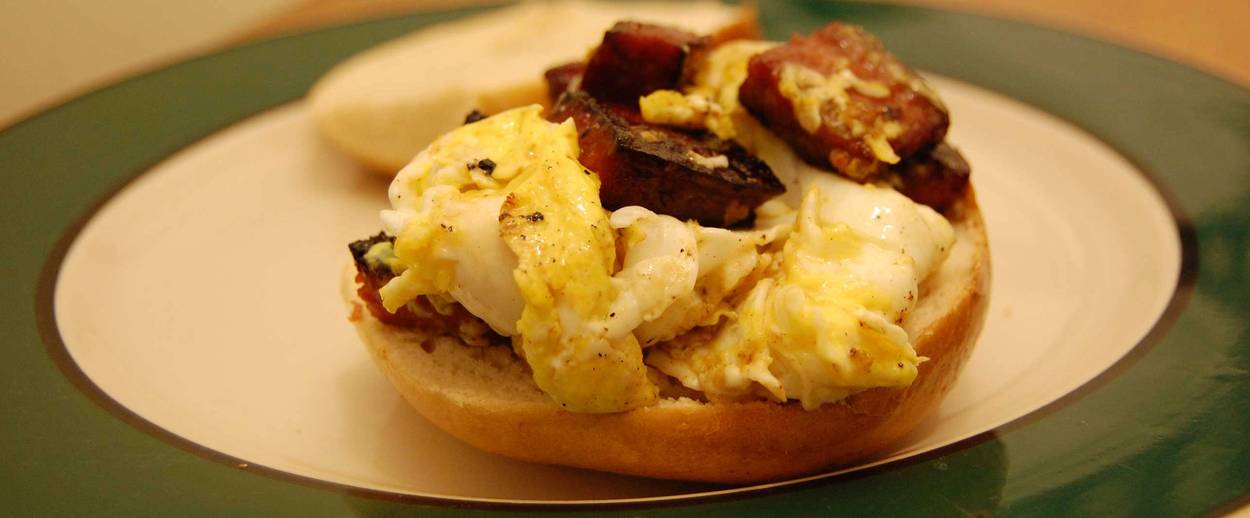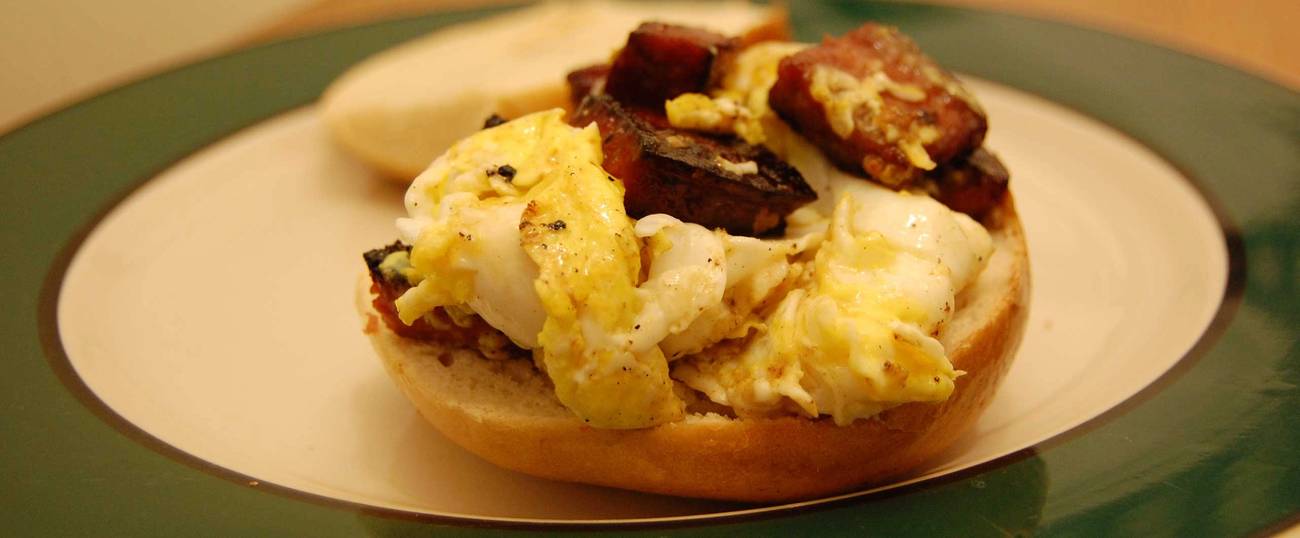From ‘Dad Food’ to Nostalgic Comfort Food
Garlicky and heavy on the cholesterol, salami and eggs—quick and simple to cook at home—became a weeknight staple for generations of American Jews




I was not fortunate enough to grow up in the era of salami and eggs. Throughout the early and mid-20th century, the dish—an umami-heavy mix of beef salami and pillowy eggs—was a weeknight staple for Ashkenazi Jewish families. And for a generation of American Jews, it holds deep nostalgic appeal. But by the time I was being raised in the 1980s and ’90s salami and eggs had fallen by the wayside, victim of those decades’ obsession with all things low-fat and low-cholesterol. I sure missed one delicious boat.
Salami and eggs can certainly be served at breakfast, but like matzo brei, noodles and cottage cheese, or its closest cousin lox, eggs, and onion, the dish also offers a trifecta for ideal quick dinners: flavorful, filling, and profoundly foolproof. From start (slicing the salami into thick rounds, cubes, or matchsticks and whisking a couple eggs in the bowl) to finish (daubing the jumble with a bit of yellow mustard), the entire process takes under 15 minutes. For many Jewish families, the dish was considered “Dad food,” meaning a dish that was simple enough for a culinarily challenged father to whip up for himself and the kids when Mom had an evening mah-jongg game.
More adventurous cooks might add sautéed onions, mushrooms, or fresh herbs, but they are hardly necessary. As with other elemental recipes, the basic ingredients are the things that matter. “The key here is the salami itself, which, whether kosher or kosher-style, should be gently firm beef sausage with heady bursts of garlic, pepper, and enough dots of white fat to render it lusciously chewable,” writes legendary food writer Mimi Sheraton in 1,000 Foods to Eat Before You Die. (Why did she include salami and eggs in such an illustrious list of must-try foods? Suffice it to say that Sheraton is also notably the co-author of a 1985 book called Is Salami and Eggs Better Than Sex? Memoirs of a Happy Eater.) The proper salami for salami and eggs is rather unlike traditional Italian or French-style salamis, which tend to be quite hard and potent. As food writer and salami and eggs devotee Edward Schneider wrote on The New York Times’ now defunct Diner’s Journal blog, it is “more of a non-pork variation on the typical Eastern European garlic sausage—think kielbasa. This is no surprise when you consider where most of New York’s Jews came from. More Pinsk than Padua.”
Today salami and eggs lives on—sometimes served as a scramble and other times as a flat, pancake-style omelet—on Jewish delicatessen menus from 2nd Avenue Deli and Katz’s in New York to L.A.’s Canter’s and Langer’s. In Brooklyn, the kitchen at artisanal delicatessen Mile End offers a dish called a Mish Mash. Inspired by a skillet breakfast that owner Noah Bernamoff grew up eating at Montreal’s Cosmo Diner, it combines salami and sliced hot dog, along with sautéed peppers and onions, in a three-egg scramble. And yet, when compared with a towering pastrami sandwich or a plate of hot brisket with gravy, it is hard to justify spending one’s restaurant budget on a couple of eggs and a bit of fried meat. Ultimately salami and eggs shines brightest at home, where the perfectly uncomplicated dish serves as a balm and a comfort after a long day.
Fortunately, when it comes to Jewish soul food dishes with comeback appeal for contemporary home cooks, salami and eggs tops the list. Food writer Arthur Schwartz told me he remembers chubby logs of salami from Lower East Side kosher deli/Chinese restaurant hybrid Schmulka Bernstein’s hanging on a hook next to his family’s refrigerator. Bernstein’s closed in the early 1990s, but worthy options remain. According to Sheraton, the best salami for the task is a supermarket staple. “You needn’t look far to find the gold standard,” she writes. “Hebrew National’s version, virtually ubiquitous, is it.” Meanwhile, for cooks who hold by a stricter kashrut certification than Hebrew National offers, Abeles & Heymann and Grow & Behold offer tender, garlicky salamis that fit the bill. With the salami issue sorted, just crack a few good quality, golden-yolked eggs and heat up a frying pan. Dinner is on its way.
***
Like this article? Sign up for our Daily Digest to get Tablet magazine’s new content in your inbox each morning.
Leah Koenig is the author of The Jewish Cookbook,Modern Jewish Cooking: Recipes & Customs for Today’s Kitchen, and The Little Book of Jewish Appetizers.
2 tablespoons vegetable oil
2 inches kosher salami, cut into rounds, small cubes, or matchsticks
6 large eggs
1/2 teaspoon kosher salt
1/4 teaspoon freshly ground black pepper
Rye toast and yellow mustard, for serving
1. Heat the vegetable oil in a medium nonstick frying pan set over medium heat. Add the salami and cook, stirring occasionally, until lightly browned and sizzling, about 5 minutes.
2. Meanwhile, whisk together the eggs with the salt and pepper in a medium bowl. Pour the eggs over the fried salami, lower heat to medium-low, and cook, stirring often, until the eggs are cooked through, 4 to 5 minutes.
3. Remove from heat and transfer eggs to a serving plate. Serve warm, with toast and yellow mustard on the side.
Serves 2 to 3